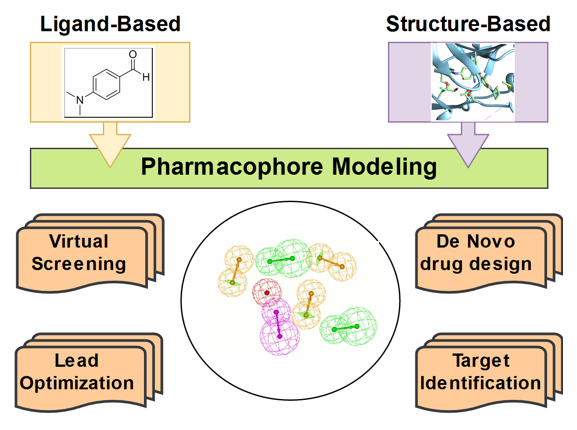Pharmacophore approaches are successful subfields of computer-aided drug design (CADD) which have become one of the major tools in hit identification, lead optimization, and rational design of novel drugs. A pharmacophore model is the ensemble of common steric and electronic features that are necessary to ensure the optimal molecular interactions with a specific biological target and to trigger (or block) its biological response. It can be used to represent and characterize molecules on schematic 2D or 3D level by identifying the essential properties of molecular recognition. Every type of atom or group in a compound can be reduced to a pharmacophore feature (or pharmacophore fingerprints). These molecular patterns would be labeled by several chemical properties, such as hydrogen bond donors or acceptors, aromatic, cationic, etc, which can be used to analyze the similarity among a library of small molecules and identify the key contributing features to the biological function.
Profacgen takes advantage of the most state-of-the-art techniques and software tools for pharmacophore modeling. Depending on the situation and the type of experiment, multiple strategies are available to construct pharmacophore models either in a ligand-based manner, or in a structure-based manner.

In the absence of the macromolecular target structure, ligand-based pharmacophore modeling is an essential stratege for drug discovery. In this method, the common chemical characteristics from 3D structures of multiple known ligands are extracted through ligand alignment, which would represent the essential interactions between ligand and potential macromolecular target.
The structure-based pharmacophore modeling generates chemical features of the active site and the sterical relationships from 3D structure of macromolecular target or macromolecule-ligand complex. It probes the possible interaction sites between the macromolecular target and the ligands.
Profacgen provides pharmacophore modeling services from a basic concept to a well-established CADD pipeline with applications including virtual screening, ADME-tox prediction, lead optimization, drug target identification and so on.
The service of pharmacophores modeling is highly customizable according to the specific requirements from the customers. Please do not hesitate to contact us for more details about our computer-aided drug design service.
Fill out this form and one of our experts will respond to you within one business day.